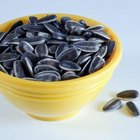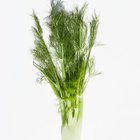Different groups recommend different numbers of servings per day of fruits and vegetables, but before you can meet any of the guidelines, you need to understand what exactly makes up a serving. In general, a serving of produce is often smaller than most people expect, making it fairly easy to get your recommended amount no matter which guidelines you are following.
Recommendations
The American Cancer Society recommends consuming five or more servings of fruits and vegetables a day and the Centers for Disease Control and Prevention, or CDC, recommends consuming a variety of produce, with the specific number of servings depending on age, sex and activity level. The 2005 Dietary Guidelines for Americans base their recommendation on caloric intake, calling for four servings of fruit and five servings of vegetables for someone on a 2,000-calorie diet and three fruit servings and four vegetable servings for people consuming 1,600 calories daily.
Importance
Individuals who get five or more servings of fruits and vegetables a day have a lower risk of myocardial infarction, chronic heart disease and stroke, according to the Linus Pauling Institute. Adequate intake of fruits and vegetables might also help prevent cancer, diabetes, osteoporosis, eye diseases, chronic obstructive pulmonary disease and neurodegenerative diseases. In general, the most colorful fruits and vegetables have the most antioxidants and nutrients, so you should try to get most of your produce intake from orange, yellow, red, green and blue foods instead of white or cream colored varieties.
Fruit Servings
A serving of fruit is equivalent to one medium piece of fruit, such as an apple, banana or peach, or 1/2 cup of chopped fruit, berries, grapes other small fruits. A serving of dried fruit is 1/4 cup. Six oz., or about 3/4 cup, of fruit juice made from 100 percent juice is a single serving.
Vegetable Servings
One cup of green leafy vegetables, such as spinach, Swiss chard or kale, makes up a single serving. For raw or cooked root vegetables, beans and other non-leafy variants, 1/2 cup is a serving. Vegetable juice provides a single serving in 3/4 cup, or 6 oz.
Visualization
Sometimes it is easier to visualize serving sizes, especially when you don't have a measuring cup handy. A medium fruit is about the size of a tennis ball and is the average size of most round fruits. Because a grapefruit is larger than most fruits, 1/2 of a grapefruit is typically equivalent to one medium fruit. Large vegetables such as a large sweet potato, potato, bell pepper and ear of corn make up two servings each. One cup of vegetables is comparable to the size of a baseball. Four leaves of lettuce make up one cup. Six baby carrots or five broccoli florets make up a 1/2 cup serving each. A 1/2 cup serving is about 16 grapes or 4 large strawberries. A small box of raisins is a single 1/4 cup serving of dried fruit.
Related Articles

Serving Size of Steamed Asparagus

How Much Whole Grain Should You Eat a ...

How Many Calories Does a Small Banana ...

Consequences of Not Eating Fruits & ...
How to Julienne Mint
How to Wash Fresh Fruit With Peroxide

What Is Yellow Zucchini?

How to Blanch Tomatillos

Are Sunflower Seeds Nuts?

10 Worst Non-Organic Foods

Dinner for a Balanced Diet

Difference Between Men's & Women's ...

How to Julienne Fennel

How to Juice a Daikon Radish

How to Roast Beets for Canning or ...

Fun Icebreaker Activities for Married ...

Foods With 20 Grams of Fiber

How to Blanch Kale for Freezing

How to Make a Cone Hat With Felt

Why Are Fruits Important?
References
Writer Bio
Bridget Coila specializes in health, nutrition, pregnancy, pet and parenting topics. Her articles have appeared in Oxygen, American Fitness and on various websites. Coila has a Bachelor of Science in cell and molecular biology from the University of Cincinnati and more than 10 years of medical research experience.